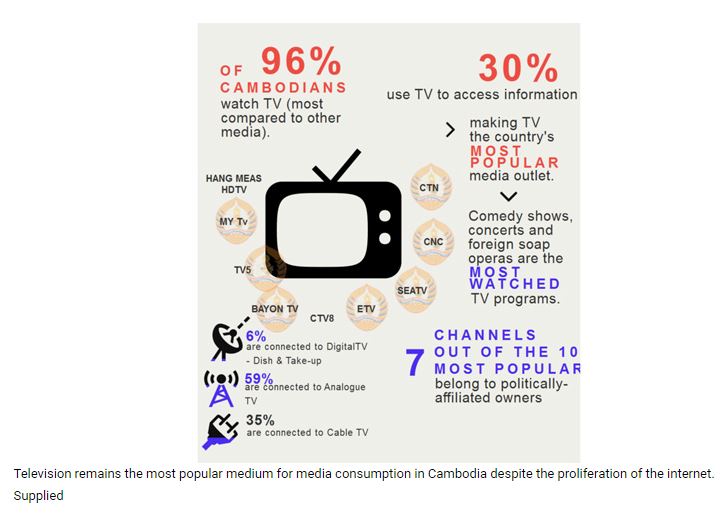Cambodia: TV ads still effective and lucrative in the Kingdom
Despite the cord-cutting and digital-first phenomenon sweeping the globe, television advertisements in the Cambodian market remain a lucrative option for firms promoting a mass-market product.
That’s according to Nancy Jaffe, former director for Nielsen Ratings’ Southeast Asia Cross-Platform Audience Measurement division in Singapore.
“Digital advertisements are useful when targeting young, affluent urban professionals but television ads are still extremely relevant in Cambodia, particularly among the rural population or if you want to reach a broader segment of the population,” Jaffe said.
One of the reasons for this is because the Kingdom’s TV landscape is shaped by over-the-air broadcast television, which is freely available to anyone with a TV set. This circumvents the cord-cutting trend because the only way to opt-out in rural Cambodia is to stop watching television or remove your set.
Television remains the most popular type of media in Cambodia, reaching 96 percent of the Cambodian audience, according to Media Ownership Monitor Cambodia (MOMC) – a not-for-profit research and advocacy and transparency group dedicated to media ownership.
“Televised advertisements are more powerful and better value for money for advertisers in Cambodia than in other parts of the world,” Jaffe said, adding that it is particularly useful for mass-market products like snacks or beverages.
“They also are especially impactful because there has not been a proliferation in the number of television channels as there has been abroad, where many people can access up to 500 channels. There are quite a few here, but not quite as much as in Singapore or the US,” stressed Jaffe, who is now chief strategy officer for Phnom Penh ad firm MangoTango Asia.
Her creative ad agency services clients including Accenture, Google, Heineken and Phnom Penh Commercial Bank. Jaffe said that when clients want to reach a more affluent demographic, they often choose to spend money on digital ads. She did, however, note that certain television programmes, such as business news, still attract ad buys from clients reaching out to wealthier audiences.
The data garnered from digital ads is one of the reasons why some firms prefer to go online. Firms can measure engagement through clicks, response and even how many people followed through to buying a product.
A challenge, however, is that unlike elaborate audience measurement systems that have been established and matured in other markets by firms such as Nielsen, Cambodia has less reliable metrics sourced through surveys.
Jaffe said that these surveys reveal that the most popular shows in the Kingdom are often reproductions of western shows, such as Cambodia’s Got Talent or Cambodian Idol. Many of them are watched in the provinces where families continue to gather around shared television sets for entertainment, unlike in the capital and other urbanised areas.
She added that many television shows are broadcast online after they are originally aired, which allows advertisers to reach both digital and analogue audiences.
Noting that Cambodia statistically has high internet penetration, Jaffe said that it is important to remember that this considers the number of subscriber identification module (SIM) cards and not actual users.
“Cambodia lags in digital consumption. Interestingly, the younger audience consumes at the same level as in Thailand and Singapore, but things are different here.
“In Singapore, everyone, from the grandparent to grandchildren is staring at their devices. It is rare to see that level of consumption here. Cambodians are slightly less addicted, maybe because of the level of affluence, but people are less likely to have individual or multiple devices,” Jaffe said.
Source: https://www.khmertimeskh.com/50821005/tv-ads-still-effective-and-lucrative-in-the-kingdom/


 English
English




